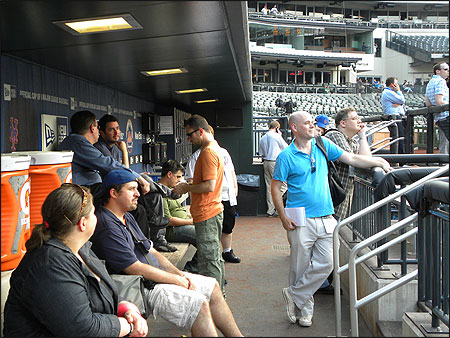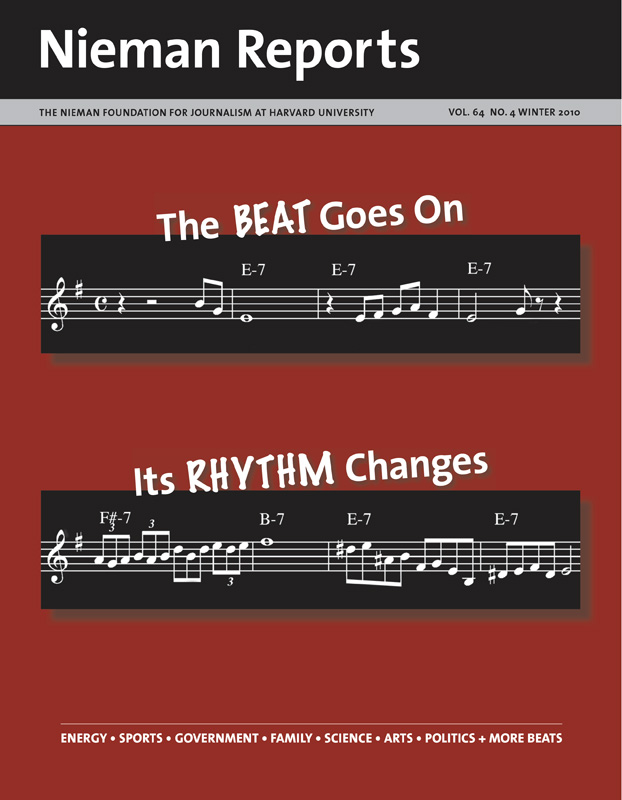
Jason Fry, standing in the New York Mets dugout with notebook in hand, was among the bloggers who were invited to cover the game as credentialed press. Photo by Kerel Cooper.
In early 2005 as a technology columnist for The Wall Street Journal Online, I returned repeatedly to blogging as a subject. It was a rich vein to mine, but there was only one problem: I’d never been a blogger.
I decided to spend spring training blogging about the New York Mets, whose routine miseries and occasional successes I’d followed avidly since I was seven. Six weeks seemed long enough for me to learn blogging’s routines and be able to talk about it authoritatively, and I thought it might be fun. So I asked my friend Greg Prince to split the writing, found a blog-hosting service that worked for both of us, and a few hours later we were the proprietors of Faith and Fear in Flushing.
I had no idea that our six-week experiment would last five years (and counting) or that I’d begun an uneasy dialogue with myself about journalism and fandom, access and independence. That conversation has grown more complicated in recent years as newspaper veterans have fled to the Web and teams have experimented with accrediting independent bloggers. Amid blurred lines, I feel simultaneously like an outsider and an insider: Are the Mets my “beat,” except I write from an outsider’s point of view? Am I a sportswriter, a fan, both or neither?
The Beat as Blog
One part of the blogging life was a surprise. I’d been writing for the Journal for a decade, and its name gave me a certain readership and visibility; what I wrote was taken seriously. On the blog, though, I was just Jason, with no affiliation or connections. My writing had to stand for itself.
And it did: By the end of our first year, Greg and I had a decent-sized audience, had been referenced not just by other blogs but also by newspapers, and had appeared on TV to talk about the Mets. At least one revolutionary claim about blogs had proved true: The Web really was a meritocracy, a talent show open to anyone who was willing to work at writing and building an audience. I’d seen that for myself.
I was 35 and an established editor and columnist so this unexpected success was a lark. But I wondered: What if I’d been 22 and found success blogging about the Mets after a day working on some anonymous lower rung of the news business? Would I have kept trying to pay my dues the old-fashioned way, hoping to parlay a job at a small-town paper into another job for a regional and eventually a chance to work night cops at the major metro? Or would I have struck out on my own, trusting in my own words and my virtual printing press? I was simultaneously relieved and a little disappointed that I had no reason to find out.
Something else struck me. Some of our readers routinely rejected arguments made by the beat writers and local columnists, dismissing them because everybody knew so-and-so had it in for the Mets. The casual assumption that journalists were biased offended me—and I was puzzled that when Greg or I criticized the Mets, we seemed to get a fairer hearing than the newspaper guys.
This seemed ridiculous: Our blog made no bones about its utter subjectivity, but we were seen as more objective than those for whom objectivity was a commandment. Paradoxically, there was a power to subjectivity: Since nobody could accuse us of being anti-Mets, our criticisms of the team were taken more seriously.
It started to feel as though the foundations of sports journalism were cracking. By my reckoning, sports journalism relied on distribution, objectivity and access. Distribution was easy: I could publish my thoughts to Faith and Fear within seconds and reach a global audience. Now, our readers’ reactions suggested objectivity wasn’t the asset I’d assumed it was.
All that was left was access. So what was its value? Yes, there were hard-working beat writers who parlayed their access into exclusive news and insightful features. But lots and lots of game stories were little more than play-by-play and paint-by-numbers quotes. Play-by-play had clearly outlived its usefulness: My big HDTV gave me a better view than the guys in the press box had, and I could see highlights on the Web whenever I wanted. If that left quotes from athletes trained to say nothing interesting, was access really such an advantage?
Columns had always been my favorite form of sports writing, but I started to notice how many of them could have been written (and probably were) without actually setting foot in the stadium. Our Faith and Fear posts were essentially columns, and often as good as the papers’ efforts. After I realized that, it no longer surprised me that the most vociferous denunciations of sports bloggers came not from beat writers, but from columnists: On some level they knew the talent pool for what they did was now a lot deeper, and they didn’t like it.
Blurring the Line
A lot of bloggers had come to similar conclusions, and saw themselves as part of a war between blogs and the mainstream media, or MSM. I sometimes wondered: If this were a real war, which side would be shooting at me? At the Journal I’d been a Web guy with a sideline as an independent blogger. Yet to bloggers who heard “Wall Street Journal” and learned I’d been a beat writer, rewrite guy, copy editor, section chief, and columnist, I was thoroughly MSM. After the Journal and I parted ways, I took a gig writing columns about sports writing and new media. I had plenty to say on the subject, but sometimes struggled to address a topic from a single perspective; my challenge was deciding which one to choose.
This year things got more complicated, and my separate worlds began to merge. The Mets reached out to some of the more-established independent bloggers, including Faith and Fear, and so one day in July I found myself on the warning track at Citi Field with a pen and a pad and a credential around my neck.
That brought me back to a long-ago decision. As a teenager working on my high school paper, I knew I’d be a journalist and assumed I’d be a sportswriter. But in my early twenties I rejected that; I knew becoming a sportswriter meant you had to stop being a fan, and I wasn’t willing to do that. If there was no cheering in the press box, I wouldn’t go in there. I’d chosen fandom and distance.
Yet now the world had changed; somehow I’d become a sportswriter anyway. Wasn’t that what I was? After all, I was a professional journalist who had written more than half a million words about the Mets and was now standing on their field with press credentials. Yet I’d never held a microphone in a locker-room scrum, and I was still an unabashed fan. Did that disqualify me?
The Mets’ media folks were there to help us if we wanted to interview players. I passed on the chance, and I’m still sorting through why. I think it’s because I’d spent five years co-writing Faith and Fear without access and never thought about what I might do if it were offered—or if I even wanted it. I wasn’t sure where I belonged, but I also wasn’t sure where I wanted to be.
Questions about access are emerging piecemeal from experiments conducted by teams and leagues and the many flavors of news organizations. Given all this tumult, I suspect I’ll never find a definitive answer to where I fit—lines will continue to blur, and questions like mine will become irrelevant. That&rsq
uo;s for the best. People should be judged by the quality of their work, not their medium or their background.
Still, I’ll always wonder.
Jason Fry co-writes the blog Faith and Fear in Flushing with Greg Prince and contributes a weekly column about sports writing and new media for Indiana University’s National Sports Journalism Center. During his 12-year career at The Wall Street Journal Online, he edited and later co-wrote The Daily Fix, a roundup of the best sports writing online. He tweets @jasoncfry. His website is www.jasonfry.net


